Picture Books
![]()
Thousands of years ago the art of storytelling began with rock paintings in the caves of Africa. Today many African children's stories are told in picture books. They show us the life in an African village, African landscapes and wild animals.
True Friends
a picture book by John Kilaka. Baobab Books, 2004, Original edition.
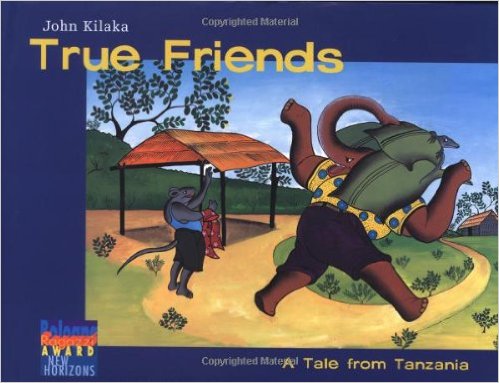 Ratz the Rat never says no – small wonder then that he is so popular. His best friend is Elephant, who prefers doing nothing while Ratz the Rat is busy collecting food. Elephant offers his friend part of his house as a larder. Ratz the Rat accepts – good friends are always trustworthy. But when the big drought comes and the food supply runs out, the friendship is put to a tough test.
Ratz the Rat never says no – small wonder then that he is so popular. His best friend is Elephant, who prefers doing nothing while Ratz the Rat is busy collecting food. Elephant offers his friend part of his house as a larder. Ratz the Rat accepts – good friends are always trustworthy. But when the big drought comes and the food supply runs out, the friendship is put to a tough test.
We all went on Safari
A Counting Journey through Tanzania, by Laurie Krebs. Illustrated by Julia Cairns (2009).
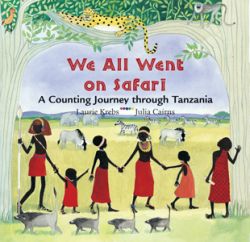
Arusha, Doto, Mosi, and their Maasai friends set out on a safari through the grasslands of Tanzania. The children encounter wild animals including giraffes, elephants, lions, monkeys, cats and other fascinating wildlife, while counting from one to ten in both English and Swahili. From spying a lonely leopard at dawn's first light (1 is moja) to watching ten elephants on a rocky hillside glen (10 is kumi), you learn interesting facts about the Massai people, about the animals of the savanna and language.
“We all went on safari
Past an old acacia tree
Nearby giraffes were grazing
So Tumpe counted three”
We learn that the Swahili word for 3 is tatu and giraffe is twiga (spelling twee-gah). And also we learn that giraffes have long, 18 inch tongues and spongy upper lips that allow them to eat around the spiky thorns of their favorite food, the acacia tree. The rhyming sing song verses are accompanied by colourful illustrations, a map of Tanzania, notes about each of the animals, and interesting facts about the Maasai people.
Mama Panya's Pancaces
A Village Tale from Kenya. Written by Rich and Mary Chamberlin. Illustrated by Julia Cairns.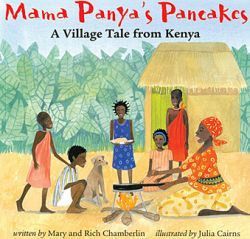 Kenyan people are known for their hospitality. That ‘s why a simple dinner can quickly turn into a feast.
Kenyan people are known for their hospitality. That ‘s why a simple dinner can quickly turn into a feast.
It’s market day and Mama Panya and her son Adika make their way to the market. Mama Panya is using her few coins to buy flour, chili and some other ingredients to make pancakes for dinner. Adika loves pancakes. He is so excited that he invites all of their friends and neighbours to join them at their meal. Mama Panya is worried. How will she feed so many people with only two coins? Luckily each person who comes brings a little something with him. This charming picture book is entertaining as well as educational. Rich and Mary Chamberlin have included a map of Kenya, informations about the country , a glossary of Swahili terms and an easy to make recipe for Mama Panya’s pancakes. The watercolour illustrations of Julia Cairns show the details of a Kenyan village. By the way, many Kenyans like to wrap food inside the pancake.
A childrens book for all ages.
The Origin of Life on Earth: An African Creation Myth
by David Anderson. Illustrator Kathleen Atkins Sight Productions 1991
This creation myth is from Nigeria, where the Yoruba live, an old folk in the West of Africa. The Yeruba believe, that in the heaven there exists the realm of the all-powerful, the god of the gods and his agents, male and female orishas. All the orishas are content, save one named Obtala, whose wondering impels him to employ his power in a meaningful way. He prepares thoughtfully for this work, aided by his fellow orishas. On a golden chain he descends from heaven. He takes soil that has been sown with the personality of the orishas and forms humans in his own image. The creatures, even the imperfect ones, are beautiful and bright. The all-powerful then brings them to life and sets the earth spinning. completing this noble, reverent, and positive tale. In the colorful illustrations, glowing with hot yellow and sapphire, ebony silhouettes are effectively set off by elegant, vibrantly patterned clothing and gold ornaments. The bright backgrounds recall batiked African textiles. Beyond myth or religion this story tells of effort, generosity, and the sacredness of life. The beauty of its illustration extends the power of the old African believe in a peaceful world.
This colourful picture book was awarded with the 1993 Coretta Scott King Award for Illustration, 1992 African Studies Association Award for Outstanding Children's Book about African Culture and several other awards.
Sosu’s Call
by Meshack Asare. Kane/Miller Book Pub, Ghana 2001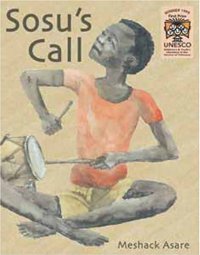 Sosu lives in a small village "somewhere on a narrow strip of land between the sea and the lagoon." Since he can’t walk, and he is also considered bad luck by the villagers, he is forced to stay at home, with only his dog for company, while his brother and sister attend school and his parents go to work. Although he is loved by his family, Sosu wonders what good it is to be a boy without a pair of strong legs. But when a storm causes the sea to flood, threatening the lives of young and old alike, Sosu conquers his fears. Led by his clever dog, he crawls through the howling wind and churning water to get to the drum that sits in the chief’s house. His drumming alerts the villagers who work in the fields, and they bring help. In gratitude for the lives he has saved, the villagers provide Sosu with a wheelchair, so that he can go to school. While there’s never any doubt Sosu will save the day, this story of overcoming a serious physical challenge to achieve acceptance may provide hope and inspiration.
Sosu lives in a small village "somewhere on a narrow strip of land between the sea and the lagoon." Since he can’t walk, and he is also considered bad luck by the villagers, he is forced to stay at home, with only his dog for company, while his brother and sister attend school and his parents go to work. Although he is loved by his family, Sosu wonders what good it is to be a boy without a pair of strong legs. But when a storm causes the sea to flood, threatening the lives of young and old alike, Sosu conquers his fears. Led by his clever dog, he crawls through the howling wind and churning water to get to the drum that sits in the chief’s house. His drumming alerts the villagers who work in the fields, and they bring help. In gratitude for the lives he has saved, the villagers provide Sosu with a wheelchair, so that he can go to school. While there’s never any doubt Sosu will save the day, this story of overcoming a serious physical challenge to achieve acceptance may provide hope and inspiration.
“Sosu’s Call” won many awards, among them the UNESCO 1st Prize for Children’s Literature, and listed for the 2001 IBBY Award, Outstanding Book for Young people with Dissabilities.
Mazanendaba and the Magical Story Shell
Illustrated by Silke Tessmer. Jacklin Publishers, South Africa 1995.
The well known story by South African storyteller Gcina Mholophe is appealing because it conveys a very uncommon explanation of how stories came into the world. Gcina tells of Mazanendaba, her sculptor-husband, and of their children. Something was sorely missing from their lives: a story. Her quest to find stories she can tell to her children and the community leads her into encounters with various people and animals. Mazanendaba’s passionate search for a story led her into the heart of the forest. None of the animals – not hares or snakes, owls or eagles, or even the elephant – had a story to tell her. Later on, however, Mazanendaba rides on the back of a dolphin, diving deep below the gleaming ocean to an underwater kingdom where the King and Queen of the Spirit People did have stories to tell!
Makwelane and the Crocodile
by Maria Hendriks. Illustrations by Piet Grobler. Human [&] Rousseau, Cape Town 2004
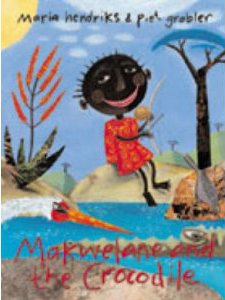 Far away, in a land of hills and rivers, lived a girl named Makwelane. Her home was down in the valley where the mealie fields weaved their way through the countryside like a big yellow snake. Makwelane desperately wants to go to visit her grandmother in a nearby village. When she’s old enough, her parents agree that she can travel by herself, as long as she is careful of the sinister old crocodile that lives in the river. In the book, we follow Makwelane on her walk to Gogo (grandmother), and how she outwits the sinister crocodile with her musical instrument. The humans, birds, beasts, and insects laugh and rejoice at her triumph. It is a beautiful journey through the African landscape, filled with humor and love. This book received the Peter Pan Award in 2010.
Far away, in a land of hills and rivers, lived a girl named Makwelane. Her home was down in the valley where the mealie fields weaved their way through the countryside like a big yellow snake. Makwelane desperately wants to go to visit her grandmother in a nearby village. When she’s old enough, her parents agree that she can travel by herself, as long as she is careful of the sinister old crocodile that lives in the river. In the book, we follow Makwelane on her walk to Gogo (grandmother), and how she outwits the sinister crocodile with her musical instrument. The humans, birds, beasts, and insects laugh and rejoice at her triumph. It is a beautiful journey through the African landscape, filled with humor and love. This book received the Peter Pan Award in 2010.

